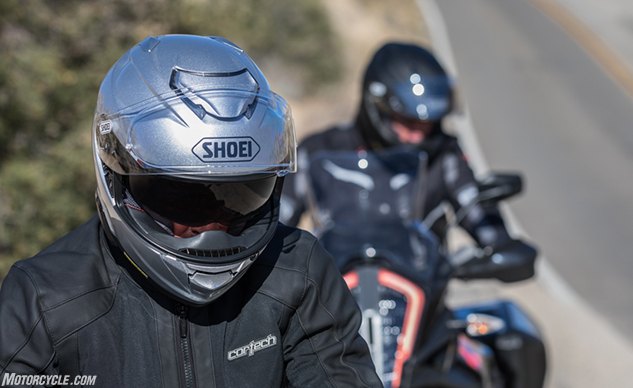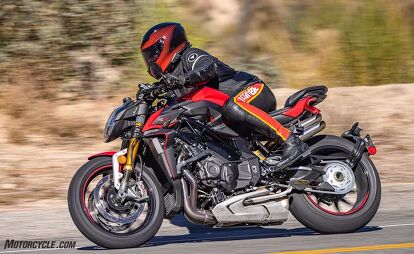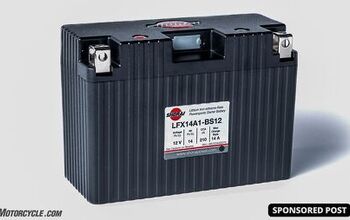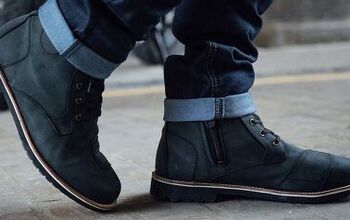Get Your Head in the Game: Best Motorcycle Touring Helmets

Light weight, smooth aerodynamics, and quietness are keys to happiness over the long haul
Touring connotes long days in the saddle, and that means long days with your head inside your helmet. Fit, then, is going to be of utmost importance when it comes to selecting a touring helmet. A helmet that gives you a hot spot might not be a huge deal when you’re only wearing it for 45 minutes. Over the course of days, though, like an annoying travel companion, an ill-fitting helmet will grow to be a thing you loathe.
Traveling to a brick and mortar store to try helmets on is the best thing you can do, and if that’s not possible then finding an online retailer with a generous return policy is the next best way to go. When you try a helmet on, keep it on for a while too. Minor annoyances that grow large over time can take a while to show themselves.
Anyway, there are hundreds of possibilities, but here we scratch the surface with eight of the best motorcycle touring helmets we’ve either sampled, or that come highly recommended from trusted sources.
Some of our favorite best touring helmets are modulars, or flip-front helmets, so see also Best Modular Helmets.
Table of Contents
Why Trust Motorcycle.com?
At Motorcycle.com, our reputation as a trusted authority in the motorcycle world since 1994 is built on our deep expertise and commitment to quality. Our team, composed of seasoned riders and industry experts, brings a wealth of knowledge and experience to every review and product recommendation we offer. We understand that when it comes to motorcycles, parts, and accessories, the right choice can enhance both performance and safety.
Our extensive range of in-depth reviews and performance tests are more than just evaluations; they are insights born from years of hands-on experience and a thorough understanding of what riders truly need. We cover every aspect of motorcycling, from sport bikes and cruisers to adventure bikes and beyond, ensuring that our recommendations cater to every type of rider.
The trust placed in us by over 2 million enthusiasts monthly is a testament to the reliability and accuracy of our advice. Whether it's selecting a new bike, finding the best accessories, or choosing the right gear for your ride, Motorcycle.com is dedicated to providing advice you can trust, backed by decades of expertise in the motorcycling field.
1. Editor's Pick: AGV K6
In our review of the AGV K6 full-face helmet, our editor highlighted its exceptional versatility and performance across various riding conditions. The K6, designed as a lightweight, do-it-all helmet, excels in both track days and touring, making it an ideal choice for riders seeking a single helmet for multiple uses.
Replacing the K5 S, the K6 offers improvements such as a lighter and more compact design, although it no longer includes the drop-down sun visor found in previous models. The helmet features a carbon/aramid shell available in four sizes to accommodate seven head sizes, optimizing both protection and comfort. The shell's construction, combined with a multi-density EPS, exceeds safety standards by 48%, according to AGV's claims.
One of the standout features of the K6 is its ease of use. The helmet's lining, a blend of Shalimar and Ritmo, provides a balance of cushioning and support, enhancing comfort during long rides. It also includes a sweat-wicking and antimicrobial liner, adjustable air vents, and a double D-ring closure to ensure a secure fit.
The visor of the K6 is pinlock-ready and provides an excellent field of view, featuring a central inset button on the chinbar for easy operation. The visor system is noted for its simplicity and effectiveness, especially when needing to switch visors.
Our editor appreciated the K6 for its light weight, at 2.9 pounds, which is significantly lighter than comparable models. This reduction in weight, coupled with the helmet’s aerodynamic profile, contributes to less fatigue during extended use. Despite a couple of minor issues with the D-ring tab fraying and some difficulty with the visor's locking mechanism, the overall experience with the helmet has been highly positive.
Priced starting around $500, the AGV K6 stands out for its combination of features, weight, and comfort, offering excellent value compared to more expensive models. The variety of graphics available for the K6 also adds a unique appeal, differentiating it from other helmets on the market.
2. Shoei GT-Air II
It has been several years since the Shoei GT-Air was first released, prompting a much-anticipated update to this premium helmet. Our editor revisited the capabilities of the original GT-Air, which was praised for its all-day touring comfort and optimal fit, to assess the new Shoei GT-Air II. This updated model continues to target touring and sport-touring riders, bringing several incremental but impactful improvements, particularly in aerodynamics, noise reduction, and comfort.
In terms of design, while the GT-Air II retains the general aesthetics of its predecessor, its shape has been fine-tuned based on wind tunnel testing to enhance aerodynamic efficiency. These changes contribute to a more stable ride at high speeds and reduce strain on the rider’s neck, crucial for both standard and sportier riding postures.
One significant enhancement is the redesigned visor baseplate system. It now features a spring-loaded mechanism that ensures a tight, air-sealed closure of the visor, effectively eliminating wind whistles. Additionally, the baseplate allows for a new venting position that slightly opens the visor, improving airflow inside the helmet which is particularly beneficial in cooler weather and helps to defog the internal sun visor and the rider’s glasses.
The GT-Air II also introduces an extended internal sun visor that offers better coverage against glare by lowering an additional 5 mm, a detail that might seem minor but significantly enhances visual comfort for the rider.
Ventilation has been upgraded as well; the chin bar's intake is larger, directing more air over the visor, while the top vent has been redesigned for easier operation with gloved hands, providing better air circulation without increasing noise levels.
The interior of the helmet features the 3D Max-Dry System, which is removable, washable, and offers superior comfort by conforming to the rider's face and dissipating sweat swiftly. The quietness of the GT-Air II is also noteworthy, comparable to the highly-regarded Shoei RF-1200, making it one of the quietest helmets available, although using earplugs is still recommended for optimal hearing protection.
The GT-Air II showcases Shoei’s commitment to quality and rider experience, integrating feedback from previous models and introducing innovations that address both comfort and functional needs of riders. This helmet represents a thoughtful evolution in Shoei's lineup, emphasizing safety, comfort, and performance, wrapped in a sleek, modern design.
3. Arai Contour-X
For over seventy years, Arai has maintained a legacy of producing premium, handcrafted helmets, emphasizing safety and performance. In our review, we found that the Arai Contour-X is no exception, offering significant enhancements in comfort and functionality designed for sporty, touring, and everyday use.
Situated just below the high-performance Corsair-X, the Contour-X finds its niche in the sport-touring category, balancing daily usability with advanced features. This model, known as the Quantic in the EU, was introduced in mid-2021 and has already garnered attention for its innovative design choices.
Arai’s commitment to safety is evident in the helmet’s R75 shell shape, which is engineered to deflect impacts more effectively, adhering to their philosophy of avoiding rather than managing impact energy. The shell utilizes Peripherally Belted Complex Laminate Construction (PB-cLc2), incorporating over 25 pieces bound by a new, more robust Z-Compound resin. Notably, Arai has reinforced the brow area—typically a helmet’s weakest point—with Superfabric, initially developed for their Formula One program.
The Contour-X introduces a wider bottom opening, enhanced by a 5 mm flare, making it significantly easier to put on and take off—a small but critical improvement for convenience in everyday scenarios. Inside, the helmet features a one-piece multi-density EPS liner, fine-tuned for optimal impact absorption at various points.
Ventilation is robust, with a new “3-D Arai Logo vent” at the front, complemented by a large aerodynamic spoiler and additional vents designed to break away upon impact, enhancing both functionality and safety. The interior boasts an odor-resistant brushed nylon liner, exceptionally soft yet supportive, and adjustable through Arai’s Facial Contour System (FCS) for a perfect fit.
For riders facing diverse weather conditions, the Contour-X excels in rain and shine. It includes a Pinlock 120 insert for fog resistance and is equipped with recessed areas for Bluetooth communication systems, making it an ideal choice for modern riders who value connectivity and comfort.
Priced starting at $740 for solid colors and $890 for standard graphics, the Arai Contour-X positions itself as a top-tier helmet for those who seek reliability, comfort, and versatility in their riding gear.
FAQs
What makes a good touring helmet?
Like we said at the beginning, it’s all about the fit. A helmet that gives you a hot spot on your forehead or wherever might not be a huge deal when you’re only wearing it for 30 minutes. Over the course of consecutive long days riding, though, an ill-fitting helmet that gives you a headache can ruin your whole ride. Never set out on a bike journey unless you’re sure you and your helmet are compatible. Great ventilation and a comfortable liner are also biggies.
How should a good touring motorcycle helmet fit?
Snug enough to stay on your head in a crash, not so snug that it causes pressure points anywhere. With the helmet strapped onto your head, reach around with both hands to the back of your head and see if you can pull the helmet off your head. Obviously, you should not be able to. A helmet shouldn’t wobble around on your head, and the liner should contact your noggin all around. Keep it on your head for 15 or 20 minutes to see if any pressure points develop, and bear in mind that interiors will loosen up a bit as they break in, like a pair of boots. Also, lots of quality helmets offer cheek pads of different thicknesses to fine-tune the fit.
Who makes the best motorcycle touring helmet?
That’s up to you. The eight we highlighted here are all top choices and good starting points to shop around and read reviews. We usually talk “Best,” which means all these are on the expensive side, but there are plenty of inexpensive helmets that are great, too.
Recent Updates
- April 12, 2024: For a better shopping experience, we have reduced the number of recommendations to three. After further testing and evaluation from our editors, we have also decided on a new list of top recommendations.
- August, 2022: Schuberth C4 Pro replaced by Schuberth C5
Additional Resources
We are committed to finding, researching, and recommending the best products. We earn commissions from purchases you make using the retail links in our product reviews and other articles. Learn more about how this works.
Become a Motorcycle.com insider. Get the latest motorcycle news first by subscribing to our newsletter here.

Motorcycle.com presents an unrivaled combination of bike reviews and news written by industry experts
More by Motorcycle.com Staff



































Comments
Join the conversation
Well I have owned a K6 for about two years and can say the Contour X is the FAR better helmet. The difference in noise and ability to communicate with Cardos is far better with the Arai. We all ride with earplugs and it’s amazing how I can now hear fairly clearly at 80 plus. The quality difference between the two explains the huge price difference. The K6 is great at its price, but they are in different leagues.
Note that the Shoei GT-Air II has a non-“D” ring chin strap. So, for all riders using glasses, one can not put on this helmet with your glasses also in your left hand. All ten fingers are required to latch this helmet and hopefully your glasses don’t get blown off of your Motorcycle seat.